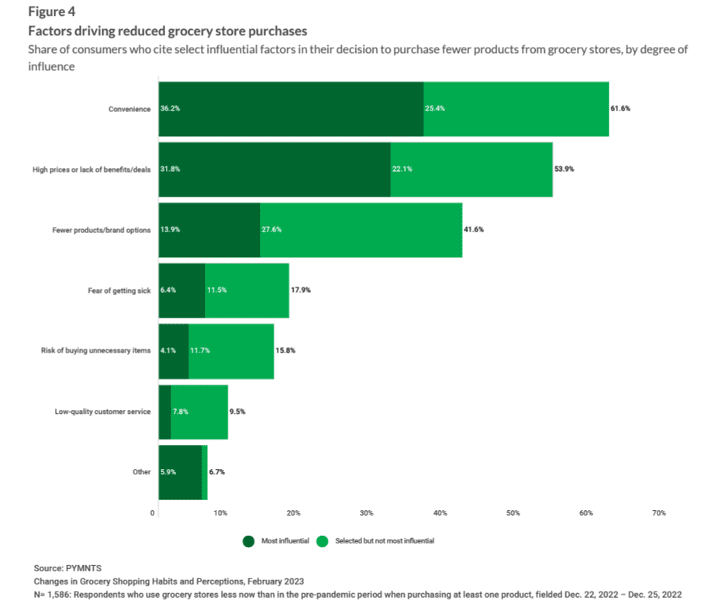Grocers Fight Back as More Grocery Spend Moves Online
February Consumer Price Index numbers demonstrate that grocers and consumers can’t catch a break.
While inflation overall seems to be easing, with gasoline and major appliances seeing year-over-year price decreases, the same can’t be said for food at home. The cost of groceries remains stubbornly high, rising 0.3% last month to reach 10.2% more than this time last year. It’s little wonder that consumers are trading down their food choices when grocery shopping and substituting packaged meals for restaurant experiences. It doesn’t help that other aisles once a part of in-store grocery shopping, such as personal care, are ceding market share to eCommerce.
However, all hope may not be lost for grocers who can’t reduce or are uneasy about reducing prices in an effort to bring in more foot traffic. As demonstrated in PYMNTS’ “Changes in Grocery Shopping and Perception,” one factor drives consumer choice on where to shop more than sales or discounts: convenience.

In-store grocers have an advantage when it comes to bringing increased traffic, virtual or physical, to their locations in consumer preferences. When surveyed, 54% of consumers said they primarily shop for fresh meat, chicken or fish in brick-and-mortar locations, with 53% doing the same for fresh fruits and vegetables. Coupled with PYMNTS’ research finding that 4 in 10 shoppers can still be lured to locations by convenience and ease, physical grocers may have a unique loyalty opportunity.
Customer convenience-led offerings can take multiple forms and may be tailored to meet grocers’ needs. The sector has experimented with convenience taking the form of self-checkout with mixed results, as 61% of consumers feel cashiers focus more on scanning than satisfaction. Instacart is so far seeing success with its Scan & Pay experimental store in Queens, N.Y., while Wegmans shuttered its scan-and-go platform last year.
Because self-service tech is evolving, satisfaction rates in the technology may change for the better. In Lisbon, cashierless tech provider Sensei launched Europe’s largest autonomous supermarket, at nearly 5,400 square feet. The store follows the “Just Walk Out” model using computer vision technology, allowing shoppers to be automatically charged for items they from the store. Stateside, autonomous retail technology company Standard AI acquired self-checkout kiosk creator Skip. Standard AI’s platform communicates information about its computer vision payment options on the screens of these more traditional self-checkout kiosks, gradually introducing shoppers to the technology.
Other grocers have seen loyalty success by boosting their digital offerings. Michigan-based chain Meijer, for example, announced the launch of an update to its mPerks loyalty program to improve its rewards personalization capabilities. Similarly, Kroger, the nation’s leading pure-play grocer, mentioned on a March analyst call how important these kinds of innovations have been in driving engagement.
And although convenience may be a particularly strong strategy, when it comes to luring customers in-store, a well-timed sale never hurt, either.
With consumer behavior already bending towards traveling to physical stores for certain groceries, brick-and-mortar grocers may be in the right position to take advantage of this predisposition. By enhancing convenience, they may well keep their customers coming back.

